When choosing backyard chickens there is so much variety to choose from! And not only is there variety in the chickens themselves, but there is lots of different egg colors to take into account as well. It’s fun to collect eggs of all different colors from your chickens! Here is a list of chickens that lay blue eggs.
This site contains affiliate links. If you make a purchase using one of these links, I may earn a commission. Please click here for more information about cookies collected and our privacy policy.
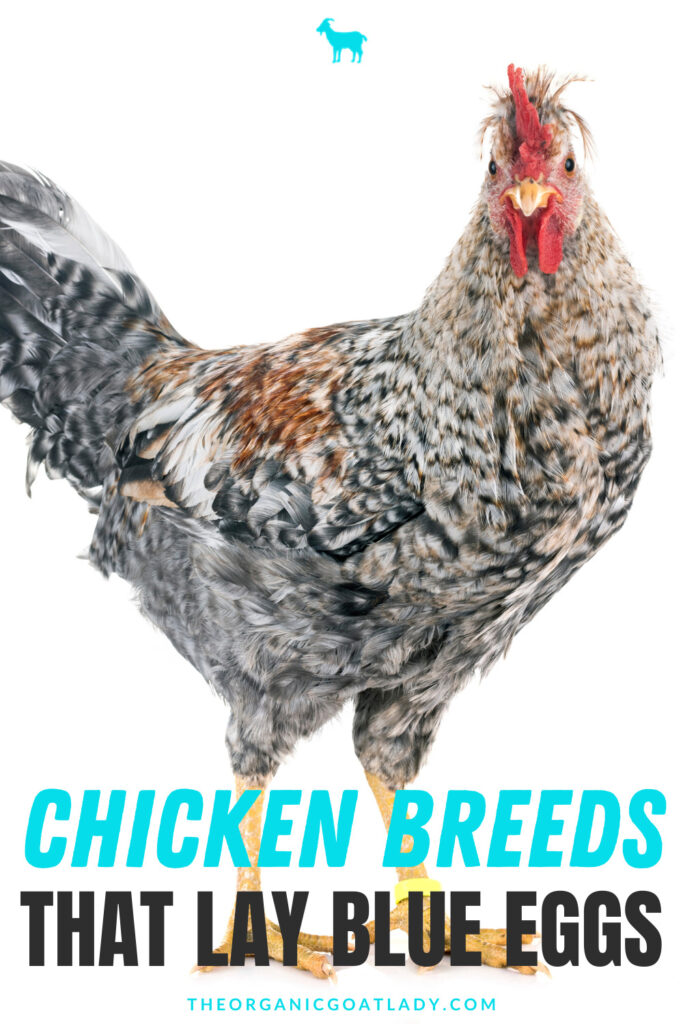
Chickens that Lay Blue Eggs
There are quite a few different breeds of chickens that lay blue eggs. Finding colorful eggs each day to add to your egg basket is exciting! It’s like finding Easter eggs;)
Why Do Some Chickens Lay Blue Eggs?
Chickens that lay blue eggs have a genetic trait that influences the color of their eggshells. The blue color is a result of a specific pigment called “biliverdin” being deposited on the eggshell during the egg formation process.
Here’s a bit more detail about why some chickens lay blue eggs:
1. Genetic Variation: The blue eggshell color is a hereditary trait that is passed down from generation to generation through the chicken’s genes. Certain breeds have inherited a genetic variation that leads to the expression of blue eggshell color.
2. Eggshell Formation: The process of eggshell formation involves the deposition of various pigments onto the shell as the egg travels through the hen’s oviduct. In chickens that lay blue eggs, the biliverdin pigment is deposited at a specific stage of eggshell formation, leading to the blue color.
4. Combination of Pigments: The blue color of the eggshell is not solely due to biliverdin. The final eggshell color results from a combination of different pigments, including protoporphyrin (which contributes to brown colors) and oocyanin (which contributes to blue and green colors). The proportions and interactions of these pigments determine the final eggshell color.
5. Different Shades: The shade of blue can vary among different chicken breeds and even among individual hens within the same breed. Factors such as genetics, diet, and the hen’s overall health can influence the exact shade of blue that appears on the eggshell.
It’s important to note that not all blue egg-laying chickens have the exact same genetic background. Various breeds and genetic lines can contribute to the blue eggshell trait, resulting in variations in eggshell color and appearance.
Are Blue Eggs Safe to Eat?
Yes, blue chicken eggs are safe to eat, just like eggs with any other color of shell. The color of the eggshell does not affect the quality or safety of the egg inside. The color of the eggshell is determined by the breed of the chicken and the pigments present during the eggshell formation process. The eggshell acts as a protective barrier that helps prevent bacteria and contaminants from entering the egg.
Whether an egg is brown, white, blue, or any other color, the internal components of the egg, including the egg white and yolk, are the same and are safe to consume when properly handled and cooked. To ensure the safety of your eggs:
1. Purchase from Reliable Sources: Obtain eggs from reputable sources, whether that’s a local farmer, a trusted store, or your own backyard flock.
2. Inspect Eggs: Before consuming an egg, visually inspect it. Cracked or damaged eggs should not be consumed as they may pose a risk of bacterial contamination.
3. **Proper Handling:** Wash your hands before and after handling eggs to prevent cross-contamination. Avoid using eggs with visible dirt or debris on the shell.
Remember that the eggshell color is purely a matter of the chicken’s genetics and the pigments present during eggshell formation. It does not impact the nutritional value, flavor, or safety of the egg itself.
Blue Egg-Laying Breeds
Chickens that lay blue eggs typically belong to specific breeds known for their unique eggshell color. The blue eggshell color is a result of a pigment called “biliverdin” being deposited on the eggshell during the egg formation process.
Here are a few chicken breeds known for laying blue eggs:
Araucana Chickens
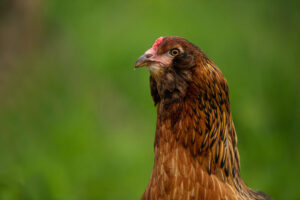
Araucanas are one of the most well-known breeds for their blue eggs. They have a distinctive appearance with ear tufts and come in various colors. The blue eggs they lay can range from light blue to turquoise in color.
Araucana chickens are a breed known for their distinctive appearance and their ability to lay blue eggs. Here’s more information about Araucana chickens:
Physical Characteristics:
Araucanas have several unique physical traits that set them apart from other chicken breeds:
1. Ear Tufts: Araucanas are known for their ear tufts, which are feathered tufts on the sides of their heads. These tufts give them a distinctive and often quirky appearance.
2. Tailless or Rumpless: Some Araucanas are tailless or have only a small tail due to a genetic trait that affects tail development. However, not all Araucanas are tailless; some may have regular tails.
3. Pea Comb: They have a small, distinct pea comb that is less prone to frostbite in cold climates.
4. Varied Colors: Araucanas come in a variety of color patterns and feather types, including both rumpless and tailed versions. Colors can range from black and white to various shades of brown, buff, and blue.
Egg Production:
One of the most famous attributes of Araucana chickens is their ability to lay blue eggs. The blue eggshell color is a result of a genetic variation that affects the deposition of pigments during eggshell formation. Araucana hens can lay eggs that vary in shade from light blue to turquoise.
Temperament:
Araucana chickens can have varied personalities, but they are generally known to be friendly, active, and curious. They can be a bit flighty due to their natural alertness, but they can also be tamed with proper handling and socialization.
Care and Housing:
Araucana chickens have the same care requirements as other chicken breeds. They need a clean and secure coop, access to fresh water and proper nutrition, protection from predators, and appropriate space to roam. Like all chickens, they benefit from a balanced diet, regular health checks, and protection from harsh weather conditions.
Breeding and Genetics:
Breeding Araucana chickens requires careful consideration of their genetic traits to avoid potential health issues associated with the tailless (rumpless) gene. Proper breeding practices can help maintain the unique characteristics of the breed while ensuring the health and well-being of the birds.
It’s important to note that there are also other breeds, like Ameraucanas and Easter Eggers, that can lay blue eggs and have similar appearances due to sharing genetic traits with Araucanas. When obtaining Araucana chickens, be sure to purchase them from reputable breeders who prioritize the health and standards of the breed.
Ameraucana Chickens
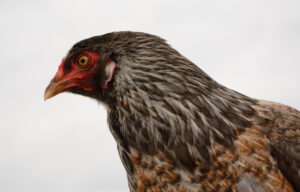
Ameraucanas are often confused with Araucanas, but they have some differences in appearance. True Ameraucanas have a beard and muffs, which are tufts of feathers around their face. Ameraucanas lay blue eggs similar to Araucanas.
Ameraucana chickens are a popular breed known for their distinctive appearance and their ability to lay blue eggs.
Here’s more information about Ameraucana chickens:
Physical Characteristics:
Ameraucanas have several recognizable physical traits that set them apart from other chicken breeds:
1. Beard and Muffs: Ameraucanas have a beard of feathers that grows under their beaks, and they also have muffs—feather tufts on the sides of their faces.
2. Pea Comb: They have a small, distinct pea comb, which is a type of comb that is less likely to suffer from frostbite in cold climates.
3. Tail: Ameraucanas typically have a full tail, unlike the tailless trait seen in Araucana chickens.
4. Variety of Colors: Ameraucanas come in a range of colors and patterns, including black, blue, wheaten, buff, and more. These color variations can also impact the color of their feathers.
Egg Production:
One of the most well-known features of Ameraucana chickens is their ability to lay blue eggs. Similar to Araucanas, this blue eggshell color is a result of genetic variation affecting pigment deposition during eggshell formation. The eggs they lay can vary in color from light blue to turquoise.
Temperament:
Ameraucanas are generally known for their friendly and docile nature. They tend to be calm and sociable, which makes them suitable for backyard flocks and family environments. Their friendly demeanor can make them easier to handle and interact with.
Care and Housing:
Ameraucana chickens have the same basic care requirements as other chicken breeds. They need a clean and secure coop, access to fresh water and a balanced diet, protection from predators, and enough space to move around. Regular health checks and proper hygiene practices are important for their well-being.
Breeding and Genetics:
Breeding Ameraucana chickens involves careful consideration of their genetic traits, especially those related to the beard, muffs, comb, and egg color. To maintain the breed’s standards and health, responsible breeding practices are essential.
When obtaining Ameraucana chickens, it’s recommended to source them from reputable breeders who prioritize breed standards and the health of their birds.
Easter Eggers Chickens
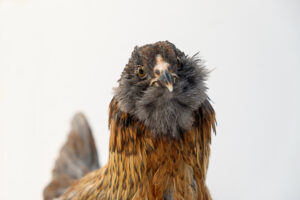
Easter Eggers are not a standardized breed but rather a mixed breed that carries the blue eggshell gene from Araucanas or Ameraucanas. They can come in various colors and patterns and are known for their colorful egg production, including shades of blue.
Easter Egger chickens are not a recognized breed like Ameraucanas or Araucanas, but rather a mix of breeds that carry the blue egg-laying gene.
Here’s more information about this hybrid breed chickens:
Origins:
Easter Eggers are often the result of breeding various chicken breeds, including Ameraucanas, Araucanas, and other breeds that carry the blue eggshell gene. Their name comes from the fact that their colorful egg production is associated with the Easter season.
Physical Characteristics:
Easter Eggers can exhibit a wide variety of physical characteristics since they are not bred to conform to a specific breed standard. However, some common traits include:
Blue/Green Eggs: Like Ameraucanas and Araucanas, Easter Eggers are known for laying eggs with blue or green shells. The exact color can vary widely.
Variable Appearance: Easter Eggers can have a diverse range of feather colors, patterns, and body types. This is because they can inherit traits from various parent breeds.
Muffs and Beard: Some Easter Eggers may have beard and muffs like Ameraucanas, but this is not a consistent trait.
Temperament:
Easter Eggers generally inherit various temperamental traits from their parent breeds. They can be friendly, active, and sociable birds. Their behavior can vary, so spending time with them when they’re young and providing proper socialization can lead to well-behaved and tame chickens.
Care and Housing:
Caring for Easter Eggers is similar to caring for other chicken breeds. They need a safe and clean coop, access to fresh water and a balanced diet, protection from predators, and appropriate space to roam. Regular health checks and good hygiene practices are important.
Egg Production:
Easter Eggers are popular for their colorful egg production. They can lay eggs with shells in shades of blue, green, or even pinkish hues. The eggshell color is a result of the genes they inherit from their parent breeds.
Popularity:
Easter Eggers are quite popular among backyard chicken keepers due to their unique appearance and colorful egg production. They offer a fun and diverse addition to a flock, adding excitement to egg collecting.
When acquiring Easter Egger chickens, it’s important to be aware that their appearance can be highly variable. If you’re looking for a specific eggshell color or physical trait, consider discussing your preferences with breeders or suppliers who have experience with these chickens.
Cream Legbar Chickens
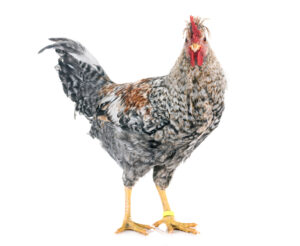
Cream Legbar chickens are a British breed known for their distinctive appearance, blue or green egg-laying abilities, and friendly personalities.
Here’s more information about Cream Legbar chickens:
Origins:
Cream Legbars were developed in the early 20th century in Britain by crossing various breeds, including Leghorns, Barred Plymouth Rocks, and Araucanas. The goal was to create a breed that not only laid well but also produced blue or green eggs.
Physical Characteristics:
Cream Legbars have unique physical traits that make them easily recognizable:
1. Crested Head: They have a small crest of feathers on top of their heads. The crest can vary in size and shape.
2. Autosexing: One of the distinguishing features of Cream Legbars is their autosexing ability. This means that male and female chicks can be differentiated by their appearance at hatching. This characteristic is particularly useful for backyard breeders.
3. Blue or Green Eggs: Cream Legbars are known for their blue or green egg-laying abilities. The color of the eggs can vary from light blue to greenish-blue.
4. Eggshell Color Variability: The eggshell color can be influenced by genetics, and not all Cream Legbars lay eggs of the same color. Some may lay eggs with a blue tint, while others lay eggs with a greener hue.
Temperament:
Cream Legbars are generally known for their friendly and active personalities. They are often considered good additions to backyard flocks due to their amiable nature and ease of handling.
Egg Production:
Cream Legbars are prolific egg layers, and their blue or green eggs are a unique and sought-after feature. Their egg production is typically good, making them a practical choice for those interested in both eggs and colorful variety.
Care and Housing:
Caring for Cream Legbars is similar to caring for other chicken breeds. They require proper housing, access to fresh water and a balanced diet, protection from predators, and space for exercise. Regular health checks and cleanliness are essential for their well-being.
Cream Legbars have gained popularity among poultry enthusiasts for their unique appearance, egg-laying abilities, and charming personalities. When obtaining Cream Legbars, look for reputable breeders who prioritize breed standards and healthy genetics.
Isbar Chickens
Isbar chickens, often referred to as “Ice Cream Bars,” are a Swedish breed known for their striking appearance, hardiness, and blue or green egg-laying capabilities. Here’s more information about Isbar chickens:
Origins:
Isbar chickens were developed in Sweden during the 20th century. They were created through selective breeding involving Rhode Island Reds, New Hampshires, and other breeds. The goal was to create a hardy breed that laid eggs in shades of blue or green.
Physical Characteristics:
Isbar chickens possess several distinctive physical traits:
1. Plumage Variety: Isbars come in different plumage colors, including blue, black, and splash. The variety in color makes them visually appealing.
2. Single Comb: Unlike some other blue egg-laying breeds, Isbars have a single comb rather than a pea comb or other comb types.
3. Egg Color: Isbars are known for laying eggs in shades of blue or green. The eggshell color can vary, producing a range of colors from light blue to greenish-blue.
4. Medium Size: Isbars are of medium size, making them a practical choice for backyard flocks.
Temperament:
Isbar chickens are often described as friendly and docile. They can be social birds and interact well with humans, which can make them a good choice for backyard enthusiasts and families.
Egg Production:
Isbar chickens are known for their egg-laying abilities. They lay eggs with blue or green shells, contributing to the variety of colors that can appear in egg cartons. Their colorful egg production is a primary attraction for many poultry keepers.
Care and Housing:
Isbar chickens have the same basic care requirements as other chicken breeds. They need a clean and secure coop, access to fresh water and a balanced diet, protection from predators, and space to roam. Regular health checks and proper hygiene practices are essential for their well-being.
Cold-Hardy: Isbars were developed in Sweden, a country with cold climates, which makes them naturally adapted to colder conditions. Their hardiness makes them suitable for various environments.
Isbar chickens offer a combination of attractive appearance, egg variety, and friendly temperament, making them a popular choice for those looking to raise backyard chickens. When obtaining Isbars, it’s important to source them from reputable breeders who prioritize the breed’s standards and health.
Whiting True Blue Chickens
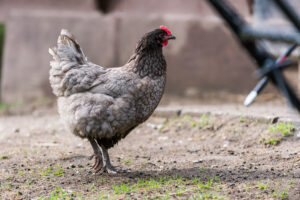
The Whiting True Blue is a relatively new breed developed for its egg-laying abilities and consistent blue eggshell color. They are a cross between the Araucana and the Rhode Island Red.
Origin and Breeding:
Whiting True Blue chickens are the result of a crossbreeding program conducted by Whiting Farms, which is primarily known for its work in developing high-quality feathers for fly tying. The aim of the breeding program was to create a breed that consistently lays blue eggs while also maintaining desirable traits like production efficiency and overall health.
Physical Characteristics:
Whiting True Blue chickens have a variety of physical traits:
1. Egg Color: As the name suggests, these chickens are bred for their ability to consistently lay blue eggs. The color of the eggs tends to be a light blue to turquoise shade.
2. Appearance: The appearance of Whiting True Blue chickens can vary as they are not a standardized breed in terms of plumage color or pattern. They may have a mix of colors, often resembling Easter Egger chickens.
3. Autosexing: One of the notable features of Whiting True Blue chicks is their autosexing ability. This means that male and female chicks can be differentiated based on their appearance at hatch, which can be advantageous for poultry breeders.
Temperament:
Whiting True Blue chickens are reported to have calm and friendly temperaments, similar to other breeds that are bred for backyard settings. This makes them suitable for families and hobbyists who enjoy interacting with their chickens.
Egg Production:
Whiting True Blue chickens are bred for their egg-laying abilities, particularly their production of blue eggs. Their consistent eggshell color can add visual interest to egg cartons and can be a point of fascination for poultry keepers.
Care and Housing:
Caring for Whiting True Blue chickens involves providing them with a suitable coop, access to fresh water and proper nutrition, protection from predators, and space for exercise. Regular health checks and good hygiene practices are important for their well-being.
It’s important to note that Whiting True Blue chickens are relatively new to the poultry scene and are not yet recognized as a standardized breed by major poultry organizations. When obtaining Whiting True Blue chickens, it’s recommended to source them from reputable breeders who have experience with this specific breed and prioritize its unique traits.
Lavender Ameraucana Chickens
Lavender Ameraucanas are a variety of Ameraucanas known for their lavender-gray plumage and blue egg production. They possess the same traits as standard Ameraucanas but come in a unique color.
Here’s more information about Lavender Ameraucana chickens:
Origins:
Ameraucana chickens are a breed known for their blue egg-laying abilities and distinctive appearance. Lavender Ameraucanas are a variety of Ameraucanas that exhibit a lavender-gray coloration in their feathers.
Physical Characteristics:
Lavender Ameraucana chickens possess several recognizable physical traits:
1. Lavender Plumage: The most distinguishing feature of Lavender Ameraucanas is their lavender-gray plumage color. This unique coloration sets them apart from other varieties of Ameraucanas.
2. Pea Comb: Like other Ameraucanas, Lavender Ameraucanas have a small pea comb, which is less prone to frostbite in cold climates.
3. Muffs and Beard: They often have the characteristic muff and beard of Ameraucanas, which are feathered tufts around their cheeks and under their beaks.
4. Blue Eggs: Lavender Ameraucanas, like other Ameraucanas, are bred for their ability to lay blue eggs. The eggs they produce can vary in color from light blue to turquoise.
Temperament:
Ameraucanas, including Lavender Ameraucanas, are generally known for their calm and friendly personalities. They tend to be docile birds that can be easily tamed, making them suitable for backyard flocks and family settings.
Egg Production:
Lavender Ameraucanas are valued not only for their unique plumage but also for their egg-laying abilities. They lay eggs with blue shells, which can add variety to your egg collection and are often considered a novelty by poultry enthusiasts.
Care and Housing:
Caring for Lavender Ameraucana chickens involves providing them with a clean and secure coop, access to fresh water and a balanced diet, protection from predators, and space for exercise. Regular health checks and good hygiene practices are important for their well-being.
Color Genetics: The lavender coloration in Lavender Ameraucanas is due to a specific genetic mutation that affects feather pigmentation. It’s important to note that breeding for specific colors can be complex and may require careful consideration of genetics.
When obtaining Lavender Ameraucana chickens, it’s recommended to source them from reputable breeders who prioritize breed standards, health, and the preservation of their unique lavender plumage and blue egg-laying traits.
Blue Egg Layers
It’s important to note that while these breeds are known for laying blue eggs, there can be variations in egg color within a breed. Factors such as genetics and diet can influence the specific shade of blue or blue-green. If you’re interested in raising chickens that lay blue eggs, research the specific breed and consider factors like their temperament, egg production, and care requirements to find the best fit for your needs.
If you would like to have a variety of egg colors then be sure to check out:

